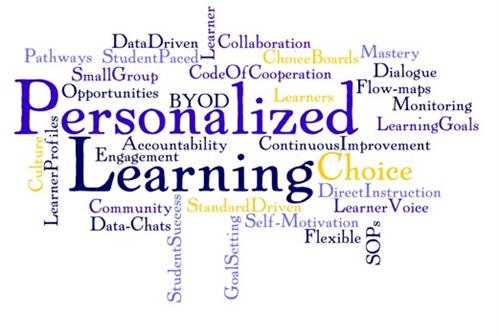Personalized Learning is also called student-centered learning, since the general goal is to make individual learning needs the primary consideration in important educational and instructional decisions, rather than what might be preferred, more convenient, or logistically easier for teachers and schools.
Personalized learning is a diverse variety of educational programs, learning experiences, instructional approaches, and academic-support strategies that are intended to deal with the distinct learning needs, interests, aspirations, or cultural backgrounds of individual students.
Generally seen as an alternative to so-called “one-size-fits-all” approaches to schooling in which teachers may, for example, provide all students in a given course with the same type of instruction, the same assignments, and the same assessments with little variation or modification from student to student.
Purpose
- To facilitate the academic success of each student by first determining the learning needs, interests, and aspirations of individual students, and then providing learning experiences that are customized—to a greater or lesser extent—for each student.
- To accomplish this goal, schools, teachers, guidance counselors, and other educational experts may employ various educational methods, from intentionally cultivating strong and trusting student-adult relationships to modifying assignments and instructional strategies in the classroom to entirely redesigning the ways in which students are grouped and taught in a school.
Concepts
- Reconfiguring the operational and educational structure of a large school so that students are organized into smaller groups and paired with a consistent team of teachers who get to know the students and their learning needs well. A few of the most common approaches are “smaller learning communities,” teaming, themed-based academies, or “schools-within-a-school”—an approach that involves the creation of distinct academic programs, or “schools,” within the operational structure of larger school.
- Eliminating the practice of grouping students into different academic “tracks” or tiered course levels based on their perceived ability or past academic performance—a practice called “heterogeneous grouping” or “mixed-ability grouping,” in which students of various ability levels are enrolled in the same course or program. In these cases, as well as in other educational settings, teachers may employ a variety of personalized instructional and academic support strategies generally called differentiation, differentiated learning, or differentiated instruction.
- Schools may create or offer students a variety of learning pathways—i.e., a wider and more diverse selection of learning experiences. Common examples include career-related internships that allow students to satisfy school graduation requirements or meet state-required learning standards; dual-enrollment experiencesthat allow students to take courses at alternate institutions, such as colleges or universities, while also earning academic credit at their home school; or independent-study projects, which allow students to self-design learning experiences in collaboration with a teacher, mentor, or advisor.
- Students may create and maintain personal learning plans, which describe their academic, collegiate, and career goals, while mapping out the educational decisions they need to make to achieve their goals, or portfolios, which are a cumulative record of a student’s academic work and accomplishments. Teachers, advisors, and educational specialists may use these plans and portfolios to guide how they teach and support specific students.
- Replacing more traditional homeroom periods or study halls with advisories—time in the school day for educators to meet with small groups of students and advise them on academic, social, and postsecondary-planning issues. Students may also be paired with advisors, adult mentors, or peer mentors who meet regularly with students over the course of several months, a year, or multiple years to help them acclimate to a school, navigate educational options, or plan for higher education and careers after graduation.
- Using alternative educational approaches and instructional methods—such as authentic learning, blended learning, community-based learning, or project-based learning, to name just a few—that may give students more personal choice in their education and more opportunities pursue learning experiences that reflect their personal interests, career aspirations, or cultural heritage. Increasingly, a variety of digital and online learning options are being used to personalize learning for students.
- Increasing the level of choice and personal responsibility students have in the instructional process. The concept of “student voice” refers to the values, opinions, beliefs, perspectives, and cultural backgrounds of individual students and groups of students in a school, and to instructional approaches and techniques that are based on student choices, interests, passions, and ambitions. As an alternative to more traditional forms of instruction in which teachers may make unilateral decisions with little or no input from students, introducing more student voice into the learning process in one way to personalize learning.
